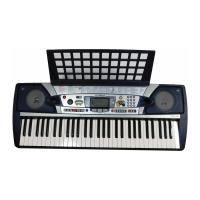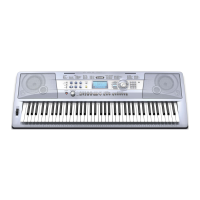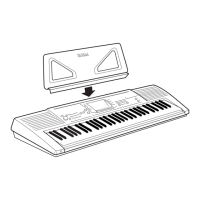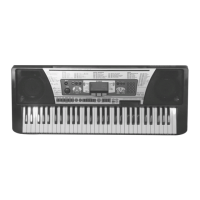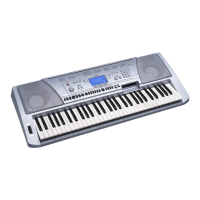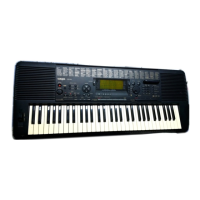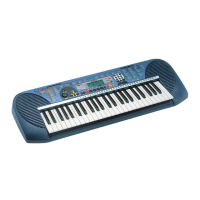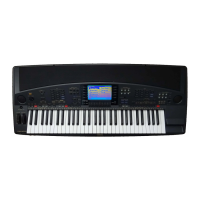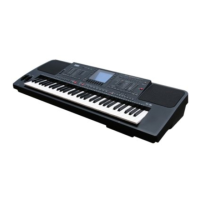
Do you have a question about the Yamaha Portatone PSR-282 and is the answer not in the manual?
| Brand | Yamaha |
|---|---|
| Model | Portatone PSR-282 |
| Category | Musical Instrument |
| Language | English |
General product use, battery warnings, and disposal.
U.S. FCC regulations and compliance statements.
Avoid electrical shock, fire, and damage from misuse.
Guidelines for power, cleaning, placement, and battery care.
Learning tools for studying and practicing music.
Function for realistic piano performance.
Feature for contemporary sounds and rhythms.
Identification and function of front panel buttons and controls.
Description of MIDI, Sustain, Phones/Output, and DC In jacks.
Details on AC adapter and battery power options.
Guidelines for connecting headphones, amps, footswitches, and MIDI.
Introduction to selecting and playing instrument voices.
Guide to selecting from 256 instrument voices.
How to use the DJ feature with its sounds and styles.
Guide to playing preset and demo songs.
How to play the built-in demonstration songs.
How to select and play individual songs.
Guide to recording multi-track songs.
Guide to using auto accompaniment features.
How to play chords with the left hand for backing.
Using the Dictionary to learn specific chords.
Guide to using the Lesson feature for practice.
Explains Timing, Waiting, Minus One, and Both Hands lessons.
Performance evaluation and voice feedback functions.
How to adjust the song's tempo.
Shows operating conditions and access to settings.
Displays notes, keyboard input, measure, and beat marks.
Shows chord type, song/voice/style name, and tempo.
Shows track status and active effects (Touch, Harmony, Sync Stop, Accompaniment).
How to activate the Portable Grand piano sound.
How to call up and adjust the metronome tempo.
Setting time signature and adjusting volume.
How to activate and play the DJ feature.
Introduction to the 256 voices, Split, DJ, Drum Kits, and effects.
Methods for selecting voices via keypad or +/- buttons.
Distinguishes panel/GM voices and explains One Touch Setting.
How to change the key of the instrument.
How to adjust the fine pitch and restore default.
How to control dynamics with playing strength.
How to adjust response to playing strength.
Adds ambient "wash" to sound, with eight types.
Provides chorus, distortion, and other effects.
Enhances melodies with twenty-six harmony types.
How to select one of the 100 available styles.
Turning on, starting, and playing the auto accompaniment.
Using Tap Tempo, Sync Start, and Intros.
Methods for stopping auto accompaniment playback.
Stopping accompaniment by releasing keys.
Changing tempo and using A/B sections/fill-ins.
How to adjust the volume of the accompaniment.
Using Multi Fingering for chord input with accompaniment.
How to play chords with Single Finger and Fingered methods.
Determining the highest key for the accompaniment section.
How to use the chord book to learn chords.
Explanation of what a chord is and its components.
How to write chord names and understand intervals.
Overview of Registration Memory banks and parameters.
Steps to save custom panel settings to presets.
Steps to recall saved panel settings.
Explains the display elements during song playback.
Steps to select and play songs.
Repeating a specific phrase of a song for practice.
Replacing a song's melody voice with a panel voice.
Adjusting the tempo of song playback.
How to adjust the volume of song playback.
Data that can be recorded to tracks.
Muting tracks and recording to the Chord track.
Steps for recording to Melody tracks (1-5).
Erasing all recorded data from a User song.
Erasing recorded data from a single track.
Explains the four lesson steps and how to use the feature.
How to select parts, start, and stop lessons.
Practice note timing in rhythm with accompaniment.
Practice playing notes correctly before song continues.
Practice muted part with accompaniment.
Practice both muted parts with accompaniment.
Built-in evaluation function for practice performance.
Feature that announces lesson steps and grades.
Explanation of MIDI and its purpose in music.
Explanation of GM System Level 1 compatibility.
Explains Channel/System messages and MIDI terminal functions.
Connecting PSR-282 to a PC via MIDI terminals.
Slaving PSR-282 to a master MIDI device using external clock.
Saving and loading PSR-282 data via Bulk Dump.
Sending PSR-282 settings snapshot to a sequencer.
Addresses issues with popping sounds, noise, no sound, and unusual voice/rhythm sounds.
Addresses auto-accompaniment not turning on, song not playing, and Pianist style issues.
Addresses voice cutting off, flanging/doubling effects, and footswitch reversal.
Lists data retained when power is off (songs, settings).
Restoring factory preset conditions.
Explains the 32-note maximum polyphony limit.
Key count, touch response, and LCD display details.
Power settings and list of main controls.
Voice count, polyphony, style count, and controls.
Yamaha Education Suite, One Touch Setting, Overall controls, Effects.
Song capacity, recording types, and MIDI support.
Auxiliary jacks, amplifier, speakers, power details.
Dimensions, weight, supplied/optional accessories.
Products covered by the warranty.
Consumer duties for warranty service.
Conditions not covered by the warranty.
Contact details for Yamaha distributors worldwide.
Contact information for Yamaha's Electronic Musical Instrument Division.
